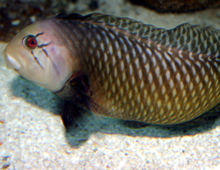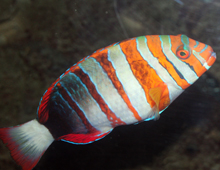Continental Shelf

Napoleon wrasse, Cheilinus undulatus
Named for its profile reminiscent of a French military cap, this fish is also known as the Humphead, and Maori wrasse (for its intricate cheek designs that look tattooed), and, because of its enormous size, Truck wrasse. The largest of all the wrasses, males can grow more than six feet in length and weigh over 300 pounds. In common with many other large Indo-Pacific reef fishes, it has been over-exploited by Chinese restaurants that serve live fishes. Trade of this animal is protected under CITES.
LEARN MORE
Magnificent foxface, Siganus magnificus
The Magnificent foxface is often considered the most attractive member of the Rabbitfish family. They are herbivorous in nature and can be seen grazing on algae throughout the day. Venomous dorsal spines and the ability to change color rapidly, help defend this coral reef dweller from predators.
LEARN MORE
Threadfin snapper, Symphorichthys spilurus
Like many wrasses, this relative of the popular red snapper undergoes remarkable changes in colors and fin shape as it reaches adulthood, but it remains quite striking throughout this process. While the long-finned youngsters have a simple but attractive geometric pattern, the short-fined adults, which can reach two feet, are festooned in electric blue stripes that have earned them the name of Chinese gown fish in Australia. This fish has a wide distribution in the Indo-Pacific.
LEARN MORE
Dragon wrasse, Novaculichthys taeniourus
While juvenile and adult Harlequin tusk fish look very similar to each other, many other wrasses undergo astounding transformations as they reach maturity. As a juvenile, this Indo-Pacific species presents a dainty appearance, with a lacy-looking pattern and fins. The formidable adults are powerful fish that work in teams, taking turns lifting rocks and coral and grabbing the animals they find.
LEARN MORE
Blue-dot stingray, Taeniura lymma
The DWA exhibits an unusually extensive series of freshwater and saltwater stingrays. This inhabitant of coral reefs from the Red Sea to the Indo-Pacific is one of the most colorful of all elasmobranchs (sharks, rays, and chimeras). It is a small stingray, never more than three feet long, including its tail. It hunts crustaceans and other invertebrates.
LEARN MORE
Harlequin tuskfish, Choerodon fasciatus
This wrasse stands out in a family well known for garish patterns and colors. Its blue teeth accent the startling combination of red, white, and yellow. It can be found from Japan to Australia, where it is sometimes called a Macaw fish. Until the 1970s it was very rare in aquariums. For a large wrasse, it is rather well behaved in community displays.
LEARN MORE
Clown triggerfish, Balistoides conspicillum
When this species first appeared in captivity more than 50 years ago, it created a sensation, and for years was known as “the most expensive aquarium fish”. Since the 1980s, it has been more frequently imported, but remains very popular. Unlike the Red-toothed triggerfish, it is an antisocial species that is never found in large numbers anywhere in its Indian Ocean and Indo-Pacific range. Triggerfish are named for the complicated structure of part of the dorsal fin, which “locks into place” so the fish can secure itself in crevices.
LEARN MORE
Red-toothed triggerfish, Odonus niger
One has to look closely at this elegant fish to see that its tiny but needle-sharp teeth are indeed a shade of dull pinkish red. This species does not have teeth as massive as most other triggerfishes, since it feeds primarily on plankton, often assembling in large schools to feast on it. It also eats sponges. Found from the Red Sea far into the Pacific, for many years it has been popular in aquariums, where it does very well.
LEARN MORE
Unicorn tang, Naso unicornis
While many surgeonfish draw attention with brilliant colors, this gray fish stands out for its bizarre shape, appearing as if it had a “nose”. Feeding on algae and plankton in the wild, it enjoys lettuce and other leafy greens in aquariums. It can be found in schools from the Red Sea to many islands in the Pacific, including Hawaii, where it is a traditional food fish. Like other surgeonfish, it has defensive “scalpels” on its tail, but they are especially noticeable with this species because they are blue.
LEARN MORE

